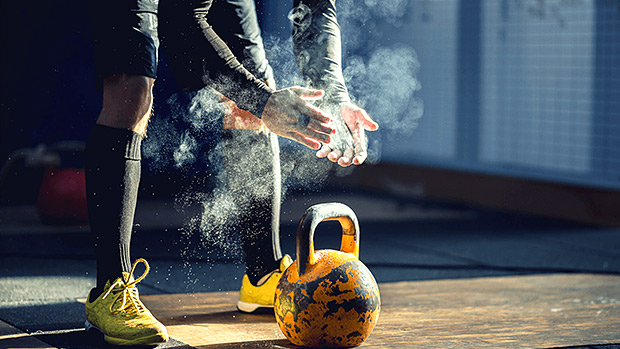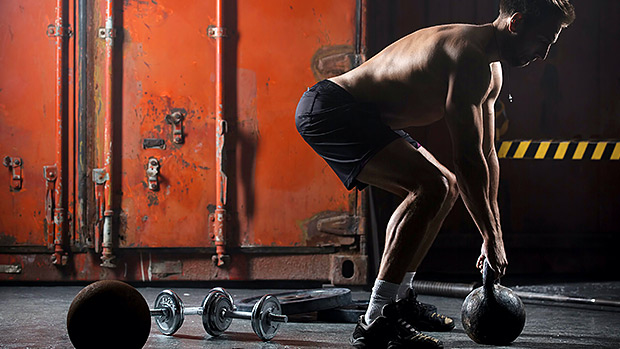Recently, I posted a picture of my daughter doing the 10,000 Swing Kettlebell Workout. Someone commented to me: "You're a little late to the party." I thought this was particularly snarky, especially since I INVENTED the damn thing in 2013.
In case you too are a little late to the party, the original workout is 20 days of 500 swings a day. Between the kettlebell swings, you do a low-volume strength movement such as chin-ups, goblet squats, dips, or overhead presses.
Within weeks of it coming out, it generated 80,000 forum posts and discussions on the internet. But, like many things, it's recently gained renewed popularity, probably because it's one of the simplest – and maybe the best – home training programs. It provides results, challenges you, and, most importantly, doesn't suck.
The trouble is, many people can't do the original workout, so I proudly offer three new options. For the record, I didn't just pull these out of my posterior. Every program I offer, every adjustment I make, is first field-tested by me and then others in my brawny circle.
Remember, though, that the original workout plan is still very good and you might learn some things about mixing swings with hypertrophy/bodybuilding work. That being said, here are my three new options.

This one is so simple that the genius of it might elude you. Just as with the original, do 500 swings a day, but do them ANY way you can get there. My daughter, Lindsay (state champion in the shot put and a KB instructor), likes this one.
Begin doing your swings. Go until technical issues or grip problems develop, or until fatigue or boredom sets in. Stop. Rest. Do mobility work or something else and, when you feel like it, continue swinging.
Just keep building on the reps. The longest journey begins with a single step. Once begun is half done. All that stuff.
I even announce where I am to the universe every single time I put the bell down just to remember where I am. Sometimes I write the number down in my journal, too. (At some point over the course of 10,000 reps, you WILL forget how many you've done. Trust me.)
Your reps could look like this:
- First set total: 13 swings
- Second set total: 24 swings (the second set starts at 14 and ends at 24)
- Third set total: 40 swings (set three might go longer than the first two sets)
- Fourth set total: 49 swings (maybe the kettlebell got a little slippery here and you put it down)
Continue to 500 swings and finish the workout and go home.
Questions?
Oddly, I get questions about this hugely complicated program:
- "How many reps per set?" As many as appropriate.
- "How many is that?" As many as appropriate.
- "How many is that?" This often goes on for days. Spring comes. The swallows return.

This is a great option if, and only if, you have lots of kettlebells. Line up all your bells on the floor. I happen to be bell-wealthy, so I line up 25 of them and do 10 reps with each of them... twice.
Boom! Done!
And, honestly, this is a really good way to do the challenge. Don't arrange them by weight, though. Get kinky. Space them out in some random pattern. It's actually fun to go from the 48-kilo kettlebell to a 10k to a 24k.
If you only have three kettlebells, order them from medium-to-light-to-heavy. If you have more than three, start and finish each round with medium bells and place the other options "inside" those two.
If you don't have any massively heavy kettlebells, do 15 reps with each bell. This will add up fast. For instance, say you have five bells. Do 15 with each. That's one round and it totals 75 reps.
The upside of this variation is that all you need to remember is the number of rounds. Do ten kettlebells for ten reps each and it'll only take 5 rounds to get to 500. Mentally, that will go by fast.

Options 1 and 2 really work well in easing the mental and physical issues that happen when you decide to swing a kettlebell 500 times a day, five days a week, for a month, but this final option can be a program that you do for the rest of your life.
Between sets of swings, you simply add a strength exercise or a mobility/flexibility exercise. I choose from the five fundamental human movements:
- Push
- Pull
- Hinge
- Squat
- Loaded Carry
I tend to utilize more one-arm work to keep things interesting. Here's a very simple example:
- 25 Swings
- One-Arm Press (left)
- 25 Swings
- One-Arm Press (right)
- 25 Swings
- One-Arm Row (left)
- 25 Swings
- One-Arm Row (right)
- 25 Swings
- Deadlift Variation
- 25 Swings
- Goblet Squat
- 25 Swings
- Marching in place with load in left hand (suitcase carry)
- 25 Swings
- Marching in place with load in right hand (suitcase carry)
- 25 Swings
- Pumps (cobra to downward dog)
- 25 Swings
Repeat.
There you go: 500 swings plus a nice, basic, full-body workout.
I don't give advice about the number of reps to do between the swings as it really varies. If you want to just do one exercise in-between swings (the original program), you'll find that you need very few reps per round to really feel it.
Also, since swings are hinges, you can certainly drop the hinge movements from the list of fundamental human movements you choose from, but I like a little hinge variation; things like rack or trap-bar deadlifts. Hip thrusts and variations are fine, too.
Everything is fine. Again, put in your own movements as appropriate. I like to pick a different group of exercises for each 250-swing round, but a few of them work well going back to back.
Remember, the swing is a hip hinge. Look for maximum hip bend and minimal knee bend. It's not a squat!
- Begin in the "Silverback gorilla" position.
- Slide the kettlebell back a bit, and vigorously "hike" the bell at your zipper.
- Hinge deeply and let the forearms slide through the thighs.
- Snap up to a vertical plank position.
There is no start or finish to a correct swing. The vertical plank is a moment to grab the 'bell and toss it back to the zipper. The hinge causes a rebound and we pop back to the plank.
Insure the following:
- Glutes clenched
- Lats connected to the shoulders
- Arms snapped directly in front of the body. Do not let the kettlebell float much higher – grab it and toss it back to your zipper. The kettlebell should not be brought overhead.
- The swing should be aggressive, explosive, and attacked with a high tempo.





